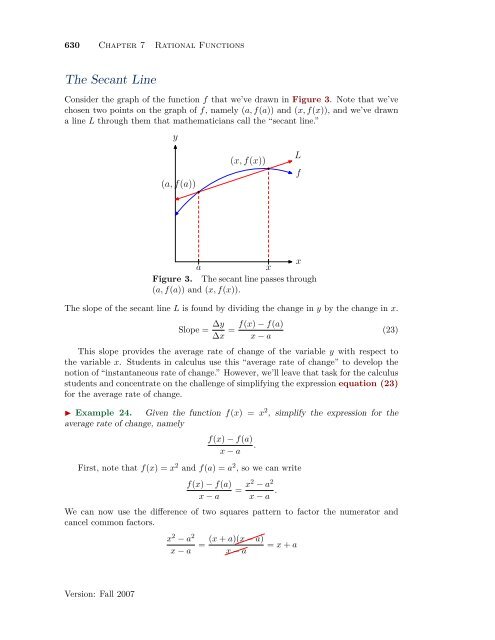Chapter 7 Rational Functions - College of the Redwoods
Chapter 7 Rational Functions - College of the Redwoods
Chapter 7 Rational Functions - College of the Redwoods
Create successful ePaper yourself
Turn your PDF publications into a flip-book with our unique Google optimized e-Paper software.
630 <strong>Chapter</strong> 7 <strong>Rational</strong> <strong>Functions</strong><br />
The Secant Line<br />
Consider <strong>the</strong> graph <strong>of</strong> <strong>the</strong> function f that we’ve drawn in Figure 3. Note that we’ve<br />
chosen two points on <strong>the</strong> graph <strong>of</strong> f, namely (a, f(a)) and (x, f(x)), and we’ve drawn<br />
a line L through <strong>the</strong>m that ma<strong>the</strong>maticians call <strong>the</strong> “secant line.”<br />
y<br />
(a, f(a))<br />
(x, f(x))<br />
L<br />
f<br />
x<br />
a<br />
x<br />
Figure 3. The secant line passes through<br />
(a, f(a)) and (x, f(x)).<br />
The slope <strong>of</strong> <strong>the</strong> secant line L is found by dividing <strong>the</strong> change in y by <strong>the</strong> change in x.<br />
Slope = ∆y f(x) − f(a)<br />
=<br />
∆x x − a<br />
This slope provides <strong>the</strong> average rate <strong>of</strong> change <strong>of</strong> <strong>the</strong> variable y with respect to<br />
<strong>the</strong> variable x. Students in calculus use this “average rate <strong>of</strong> change” to develop <strong>the</strong><br />
notion <strong>of</strong> “instantaneous rate <strong>of</strong> change.” However, we’ll leave that task for <strong>the</strong> calculus<br />
students and concentrate on <strong>the</strong> challenge <strong>of</strong> simplifying <strong>the</strong> expression equation (23)<br />
for <strong>the</strong> average rate <strong>of</strong> change.<br />
◮ Example 24. Given <strong>the</strong> function f(x) = x 2 , simplify <strong>the</strong> expression for <strong>the</strong><br />
average rate <strong>of</strong> change, namely<br />
f(x) − f(a)<br />
.<br />
x − a<br />
First, note that f(x) = x 2 and f(a) = a 2 , so we can write<br />
f(x) − f(a)<br />
x − a<br />
= x2 − a 2<br />
x − a .<br />
We can now use <strong>the</strong> difference <strong>of</strong> two squares pattern to factor <strong>the</strong> numerator and<br />
cancel common factors.<br />
x 2 − a 2<br />
x − a<br />
=<br />
(x + a)(x − a)<br />
x − a<br />
= x + a<br />
(23)<br />
Version: Fall 2007

















